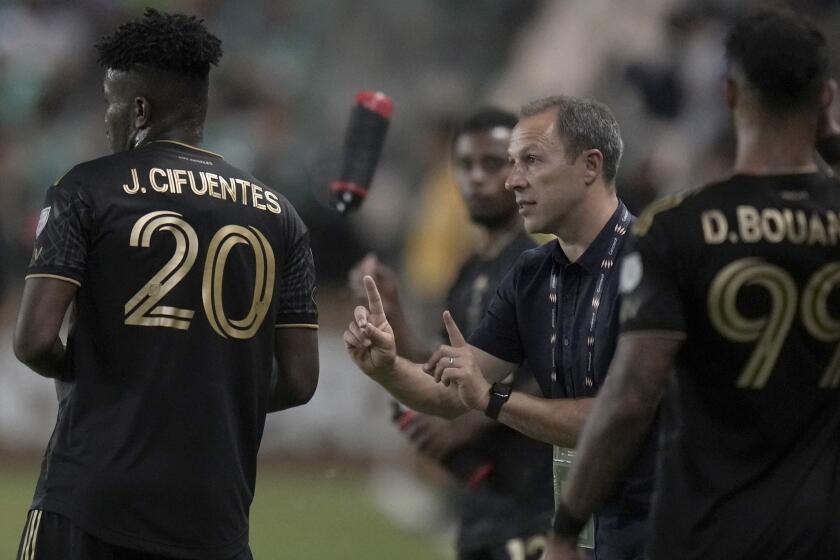Nights like this are the best hope for the future of MLS
- Share via
This was not the first time the Rose Bowl was filled to the brim with flag-waving, drum-beating soccer fans, and it won’t be the last.
The crowd of 93,137 that packed the place Saturday to boo David Beckham and support FC Barcelona in its 2-1 exhibition victory over the Galaxy was enthusiastic and knowledgeable. These fans, part of the largest crowd to see a soccer game in the U.S. since the 1994 World Cup, didn’t need to be told to clap or to scream loud enough to ratchet up a phony noise meter.
They appreciated the jaw-dropping passing of Lionel Messi and Pedro Rodriguez, the speed and skill of a game played with fervor and at a high level, and they showed it at every turn. They also showed their passion by booing Beckham for the nearly 87 minutes he played, still scornful that he’s an MLS drop-in.
Beckham, fined $1,000 last month for attempting to combat a heckler during the Galaxy’s friendly against AC Milan, silenced the jeers when he powered a free kick through the defensive wall for the Galaxy’s goal in the 45th minute.
But soon enough the crowd reverted to booing him, a sound that was sweet music to the ears of MLS Commissioner Don Garber.
“The opposite of love isn’t hate. It’s indifference,” Garber said. “We have people now that care about what goes on on our field. I’d rather deal with people having challenges and issues with some of the things that take place on the field than not care at all.
“The amount of awareness for this story has been one of the biggest stories in professional sports anywhere around the world, and that’s a good thing for Major League Soccer.”
Garber called Saturday’s game “a great night for soccer in America,” and it was. The problem is that it’s all too rare for MLS. If it’s going to thrive the league needs more nights like this. A lot more. And a lot less indifference from the sporting public.
Twenty-five years ago this month a semifinal game in the Olympic soccer tournament drew more than 97,000 fans to the Rose Bowl. The bronze-medal game drew more than 100,000 and the gold-medal game, won by France over Brazil, drew 101,799.
More recently, the eight matches played at the Rose Bowl during the 1994 World Cup averaged 89,478 fans. The final of the 1999 Women’s World Cup drew more than 90,000 fans for the U.S. team’s victory over China.
There is an audience for soccer, for the big occasions when remarkable club teams such as Barcelona visit. Yet, Saturday’s crowd was about six times bigger than the average MLS crowd, which was about 15,515 through mid-July.
The disconnect remains between fans who will come out in happy droves to see Barcelona or AC Milan play the Galaxy and the smaller crowds that file into MLS stadiums.
How to turn these fans into MLS fans is Garber’s biggest challenge.
“Part of it is creating those connections and part of it is having a night when your team can be competitive and convincing a lot of fans that might be here to see Barcelona that the L.A. Galaxy can play,” he said.
Part of the downfall of the North American Soccer League was that it overreached, placing teams in too-large stadiums that made decent-sized crowds look minuscule. MLS has smartly avoided that with a business plan that makes it more sensible for teams to invest in soccer-specific stadiums that seat 20,000 to 25,000.
You’ll see soccer in the Rose Bowl again, but it probably won’t be MLS teams facing each other.
“We’ve got to start filling up all of our small stadiums before we can start worrying on a regular basis about filling up stadiums like this outside of exhibitions,” Garber said.
Ending the general public indifference toward his league is the first step.
--







